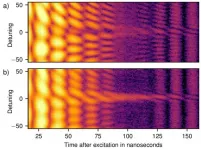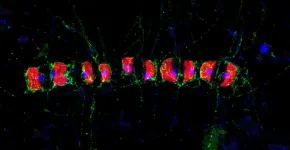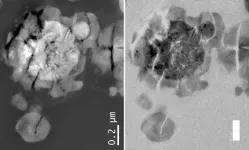(Press-News.org) From atomic clocks to secure communication to quantum computers: these developments are based on the increasingly better control of the quantum behaviour of electrons in atomic shells with the help of laser light. Now, for the first time, physicists at the Max Planck Institute for Nuclear Physics in Heidelberg have succeeded in precisely controlling quantum jumps in atomic nuclei using X-ray light. Compared with electron systems, nuclear quantum jumps are extreme - with energies up to millions of times higher and incredibly short zeptosecond processes. A zeptosecond is one trillionth of a billionth of a second. The rewards include profound insight into the quantum world, ultra-precise nuclear clocks, and nuclear batteries with enormous storage capacity. The experiment required a sophisticated X-ray flash facility developed by a Heidelberg group led by Jörg Evers as part of an international collaboration.
One of the great successes of modern physics is the increasingly precise control of dynamic quantum processes. It enables a deeper understanding of the quantum world with all its oddities and is also a driving force of new quantum technologies. But from the perspective of the atoms, "coherent control" has so far remained superficial: it is the quantum jump of the electrons in the outer shell of the atoms that has become increasingly controllable by lasers. But as Christoph Keitel explains, the atomic nuclei themselves are also quantum systems in which the nuclear building blocks can make quantum jumps between different quantum states.
Energy-rich quantum jumps for nuclear batteries
"In addition to this analogy to electron shells, there are huge differences", explains the Director at the Max Planck Institute for Nuclear Physics in Heidelberg: "They've got us so excited!" Quantum jumps between different quantum states are actually jumps on a kind of energy ladder. "And the energies of these quantum jumps are often six orders of magnitude greater than in the electron shell", says Keitel. A single quantum jump made by a nuclear component can thus pump up to a million times more energy into it - or get it out again. This has given rise to the idea of nuclear batteries with an unprecedented storage capacity.
Such technical applications are still visions of the future. At the moment, research entails addressing and controlling these quantum jumps in a targeted manner. This requires precisely controlled, high-energy X-ray light. The Heidelberg team has been working on such an experimental technique for over 10 years. It has now been used for the first time.
Accurate frequencies enable ultra-precise atomic clocks
The quantum states of atomic nuclei offer another important advantage over electron states. Compared with the electronic quantum jumps, they are much more sharply defined. Because this translates directly into more accurate frequencies according to the laws of physics, they can, in principle, be used for extremely precise measurements. For example, this could enable the development of ultra-precise nuclear clocks that would make today's atomic clocks look like antiquated pendulum clocks. In addition to technical applications of such clocks (e.g. in navigation), they could be used to examine the fundamentals of today's physics much more precisely. This includes the fundamental question of whether the constants of nature really are constant. However, such precision techniques require the control of quantum transitions in the nuclei.
Coordinated light flashes enhance or reduce the excitation
The principle of the Heidelberg experimental technique sounds quite simple at first. It uses pulses (i.e. flashes) of high-energy X-ray light, which are currently provided by the European Synchrotron Radiation Source ESRF in Grenoble. The experiment splits these X-ray pulses in a first sample in such a way that a second pulse follows behind the rest of the first pulse with a time delay. One after the other, both encounter a second sample, the actual object of investigation.
The first pulse is very brief and contains a broad mix of frequencies. Like a shotgun blast, it stimulates a quantum jump in the nuclei; in the first experiment, this was a special quantum state in nuclei of iron atoms. The second pulse is much longer and has an energy that is precisely tuned to the quantum jump. In this way, it can specifically manipulate the quantum dynamics triggered by Pulse 1. The time span between the two pulses can be adjusted. This allows the team to adjust whether the second pulse is more constructive or destructive for the quantum state.
The Heidelberg physicists compare this control mechanism to a swing. With the first pulse, you push it. Depending on the phase of its oscillation in which you give it a second push, it oscillates even stronger or is slowed down.
Pulse control accurate to a few zeptoseconds
But what sounds simple is a technical challenge that required years of research. A controlled change in the quantum dynamics of an atomic nucleus requires that the delay of the second pulse is stable on the unimaginably short time scale of a few zeptoseconds. Because only then do the two pulses work together in a controlling way.
A zeptosecond is one trillionth of a billionth of a second - or a decimal point followed by 20 zeroes and a 1. In one zeptosecond, light does not even manage to pass through one per cent of a medium-sized atom. How can you imagine this in relation to our world? "If you imagine that an atom were as big as the Earth, that would be about 50 km, says Jörg Evers, who initiated the project.
The sample is shifted by 45 trillionths of a metre
The second X-ray pulse is delayed by a tiny displacement of the first sample, also containing iron nuclei with the appropriate quantum transition. "The nuclei selectively store energy from the first X-ray pulse for a short period of time during which the sample is rapidly shifted by about half a wavelength of X-ray light", explains Thomas Pfeifer, Director at the Max Planck Institute for Nuclear Physics in Heidelberg. This corresponds to about 45 trillionths of a metre. After this tiny movement, the sample emits the second pulse.
The physicists compare their experiment to two tuning forks that are at different distances from a firecracker (Figure 2). The bang first strikes the closer tuning fork, making it vibrate, and then moves on to the second tuning fork. In the meantime, the first tuning fork, now excited, emits sound waves itself, which arrive with a delay at the second fork. Depending on the delay time, this sound either amplifies or dampens the vibrations of the second fork - just like the second push on the oscillating swing, as well as for the case of the excited nuclei.
With this experiment, Jörg Evers, Christoph Keitel, and Thomas Pfeifer and their team from the Max Planck Institute for Nuclear Physics in cooperation with researchers from DESY in Hamburg and the Helmholtz Institute/Friedrich Schiller University in Jena succeeded for the first time in demonstrating coherent control of nuclear excitations. In addition to synchrotron facilities such as those at the ESRF, free-electron lasers (FELs) such as the European XFEL at DESY have recently provided powerful sources of X-ray radiation - even in laser-like quality. This opens up a dynamic future for the emerging field of nuclear quantum optics.
INFORMATION:
Original publication
K. P. Heeg, A. Kaldun, C. Strohm, C. Ott, R. Subramanian, D. Lentrodt, J. Haber, H.-C. Wille, S. Goerttler, Rudolf Rüffer, C. H. Keitel, R. Röhlsberger, T. Pfeifer und J. Evers
Coherent x-ray-optical control of nuclear excitons
Nature, 17 February 2021
Before life emerged on Earth, many physicochemical processes on our planet were highly chaotic. A plethora of small compounds, and polymers of varying lengths, made up of subunits (such as the bases found in DNA and RNA), were present in every conceivable combination. Before life-like chemical processes could emerge, the level of chaos in these systems had to be reduced. In a new study, LMU physicists led by Dieter Braun show that basic features of simple polymers, together with certain aspects of the prebiotic environment, can give rise to selection processes that reduce disorder.
In previous publications, Braun's research group explored how spatial order could have developed in narrow, water-filled chambers ...
Epileptic activity originating from one or more diseased brain regions in the temporal lobe is difficult to contain. Many patients with so-called temporal lobe epilepsy often do not respond to treatment with anti-epileptic drugs, and the affected brain areas must therefore be surgically removed. Unfortunately, this procedure only gives seizure freedom to about one third of patients, so the development of alternative therapeutic approaches is of great importance. Scientists led by neurobiologist Prof. Dr. Carola Haas, head of the research group at the Department of Neurosurgery at Medical Center - University of ...
The major direct and indirect effects of covid-19 have forced the authorities to implement policies that strike a balance between minimizing the immediate health impact of the pandemic and containing the long-term damage to society arising from protective policies.
One parameter that is crucial for calculating how restrictive policies might be warranted is the mortality impact of covid-19, which has led to large-scale international collaborations in order to collect data that records deaths attributable to the pandemic.
Despite the limitations, each of these research avenues and associated health measures (infection rate, deaths and excess deaths) is important in order to inform the public and policymakers about the mortality impact of covid-19.
"Our results confirm that the mortality ...
When can tuberculosis therapy be stopped without risk of relapse? Doctors are faced with this question time and again, because the lack of detection of the tuberculosis pathogen Mycobacterium tuberculosis is no guarantee for a permanent cure of the lung infection. Patients who respond to the standard therapy may be out of treatment after six months. But for resistant cases, more than 18 months of treatment duration is currently advised. "This is a very long time for those affected, who often have to take more than four antibiotics every day and suffer from side effects", explains Prof. Dr. Christoph Lange, Clinical Director at the Research Center Borstel and director of the study, conducted at the German Center for Infection Research (DZIF) in cooperation with the German Center for ...
A group of researchers has developed a new program showing participation and activity is critical for the rehabilitation of older adults in long-term care.
The results of their research were published in the journal PLOS ONE on February 12, 2021.
"Our study shows participatory programs that encourage elderly patients to be active need greater emphasis in elderly care centers," said Yoshihiko Baba, lead author of the study.
In 2015, the Ministry of Health, Labour and Welfare of Japan launched a comprehensive plan to care for the country's aging population. Crucial to this was rehabilitation centered on promoting activities that elderly patients could actively take part in.
Baba, a former ...
Although amber looks like a somewhat unusual inorganic mineral, it is actually derived from an organic source - tree resins. Millions of years ago, when this aromatic and sticky substance was slowly oozing from coniferous trees, insects and other biological material could become trapped in it. That is why some samples of amber contain fossilized specimens, preserved in a virtually pristine state, which afford fascinating snapshots of the flora and fauna of long-gone forests. Now, a research team led by LMU zoologists Viktor Baranov and Joachim Haug has made exciting ...
Semi-trucks and other heavy-duty vehicles are responsible for nearly half of road transportation carbon dioxide emissions in Europe, according to the International Council on Clean Transportation. A team of researchers in Italy has proposed a plan to reduce the emissions without compromising priorities such as delivery times. They published their approach in IEEE/CAA Journal of Automatica Sinica, a joint publication of the IEEE and the Chinese Association of Automation.
"Driving style, traffic and weather conditions have a significant impact on vehicle fuel consumption. Road freight traffic, in particular, contributes ...
A major pathway for carbon sequestration in the ocean is the growth, aggregation and sinking of phytoplankton - unicellular microalgae like diatoms. Just like plants on land, phytoplankton sequester carbon from atmospheric carbon dioxide. When algae cells aggregate, they sink and take the sequestered carbon with them to the ocean floor. This so called biological carbon pump accounts for about 70 per cent of the annual global carbon export to the deep ocean. Estimated 25 to 40 per cent of carbon dioxide from fossil fuel burning emitted by humans may have been transported by this process from the atmosphere to depths below 1000 meter, where carbon can be stored for millennia. ...
Early Mars is considered as an environment where life could possibly have existed. There was a time in the geological history of Mars when it could have been very similar to Earth and harbored life as we know it. In opposite to the current Mars conditions, bodies of liquid water, warmer temperature, and higher atmospheric pressure could have existed in Mars' early history. Potential early forms of life on Mars should have been able to use accessible inventories of the red planet: derive energy from inorganic mineral sources and transform CO2 into biomass. Such living entities are rock-eating microorganisms, called "chemolithotrophs", which ...
The ability to speak is one of the essential characteristics that distinguishes humans from other animals. Many people would probably intuitively equate speech and language. However, cognitive science research on sign languages since the 1960s paints a different picture: Today it is clear, sign languages are fully autonomous languages and have a complex organization on several linguistic levels such as grammar and meaning. Previous studies on the processing of sign language in the human brain had already found some similarities and also differences between sign ...





